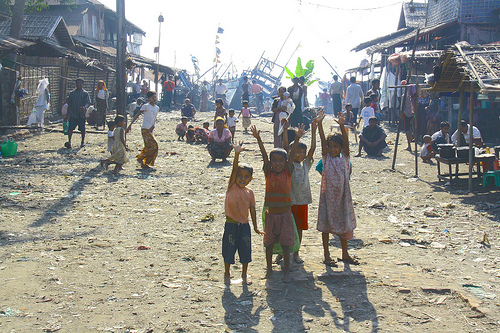The Rakhine and the Rohingya
by Than Win Htut / June 27, 2012 / No comments
Internet Racism in Burma Escalates into Armed Conflict

A Rohingya village in Rakhine State. Photo: fredalix. Creative Commons licensed.
Here are some hate-posts that have appeared on Facebook, where thousands of young people from Burma/Myanmar connect with each other:
“Kill them all.”
“Drive those Bengali to the sea.”
“Protect our motherland from invaders.”
“Stand with Rakhine, unite against Bengali.”

- Though the video journalists of Democratic Voice of Burma provide daily news stories for Burma’s media, what no one gets to see is what happens behind the camera, off screen. I ask them why they do what they do and what they see as they expose a country that has been under the shadow of dictatorships for decades.

- Than Win Htut joined Democratic Voice of Burma since 2005 as a senior producer and began working as a sub-editor in tv news last year. After leaving Burma, Than lived on the Thai-Burma border and wrote for many exiled media outlets including Khit Pyaing, Amyin Thit, The Irrawaddy Magazine, and Mizzima News. He produces his own weekly science and technology TV show called “Khit Hlaine,” working with around 40 Burmese reporters living in Thailand and 40 living in Burma. He currently lives in Oslo, Norway.
Many of these hate-posts instigated conflicts that lead to bloody riots in Rankine State, near the Bangladesh border in the northwest, where more than 60 people were killed and hundreds of houses were burned.
We at the Democratic Voice of Burma covered these riots for some long, intense weeks. In terms of maintaining professionalism in religious and racial conflicts, the riots became a serious test for our reporters and newsroom, as well as other media outlets in Burma.
Much of the unrest was deeply rooted to the decades-old conflict between the local Rakhine ethnic minority (Arakanese) and the Rohingya, who are called “Bengali” or “Stranger Muslims” by locals. Many Burmese view the Rohingya as illegal immigrants, though some have national IDs. The conflict has also been escalated by many other causes, such online posts of pictures of dead bodies, a lack of police or military action in mob-control, and the promotion of extreme nationalism and xenophobic elements through social media.
On May 28, 2012, a Rakhine woman was gang-raped and murdered in Kyauk Phyu, a town on the western coast. A few days after the murder, unknown people posted photos of the victim on Facebook without any face-blur. A few days later the names and photos of three Rohingya men who reportedly committed the crime were posted. These photos were shared by hundreds of Facebook users. Incitant terms, including “Rakhine girl,” “Buddhist girl,” “Muslim men,” and “Bengali men,” were unnecessarily used and provoked more anger against Muslims. The post made Facebook a battleground for the “virtual war of words” between different religions, appearances, origins, and ethnicities.
Soon after, on June 3, a similar conflict led to tragedy when an angry mob attacked 10 Bengali-looking passengers on a bus that was heading to the mainland. On June 5, after an overflow of pictures of the 10 mob-attack victims’ bodies appeared, state media reported on both this case and the rape in May. The report used racially discriminatory words such as Kulars (origin from Hindi); this bias triggered more anger from the other side, further increasing conflicts between local Buddhists and Muslims, Rakhine and non-Rakhine.
On the following day the state newspapers issued a correction for their use of improper words; however, it seems to be too little too late. On June 9 martial law was declared in Rakhine State.
In my next column I will talk about the challenges DVB’s reporters face while covering religious and racial conflicts in Burma.




